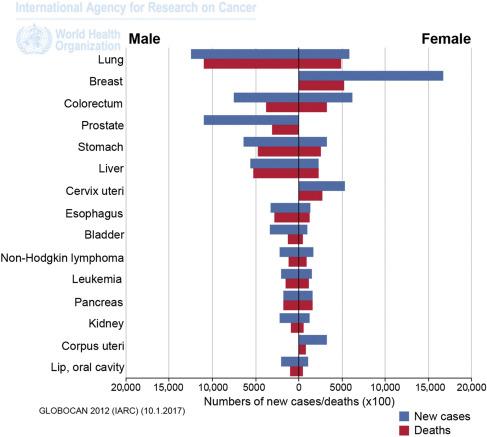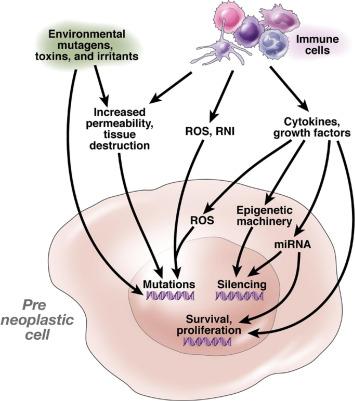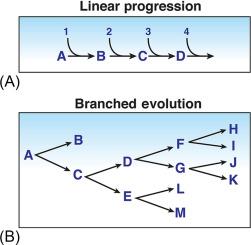Physical Address
304 North Cardinal St.
Dorchester Center, MA 02124
Gastrointestinal cancers represent a heterogeneous, complex array of disorders and diseases. They may be divided into rare inherited forms and more frequent sporadic forms. There is a critical interplay of genetic and environmental factors that foster the conversion of normal tissue to precursor, premalignant lesions, and eventually to frank malignancy. While it is apparent that certain genetic mechanisms are better appreciated in a cell-type and tissue-type specific context, there are nevertheless overarching shared features between gastrointestinal cancers of different origin. To that end, this chapter will approach gastrointestinal cancers by focusing upon a dissection of the genetic basis of gastrointestinal cancers and underlying molecular mechanisms. Thus, it is not the intention of this chapter to elaborate upon the etiologic mechanisms of each gastrointestinal cancer due to space constraints, but rather to provide the reader with an understanding of the pivotal principles of oncogenesis and use this as a platform for elucidation of the molecular steps involved in initiation, evolution, and progression of gastrointestinal cancers. Finally, this chapter will emphasize the underpinnings of epithelial-based gastrointestinal cancers since they represent the preponderant form of gastrointestinal malignancy, but certainly, gastrointestinal malignancies can emanate from different cell types and these in aggregate constitute lymphomas, sarcomas or stromal tumors, and other rare forms of gastrointestinal neoplasms.
The term neoplasia refers to a pathologic process of abnormal and unregulated cell proliferation. Neoplastic cells have lost the ability to respond to the normal cues that dictate when a cell replicates, differentiates, migrates, and dies. Continuous and unconstrained cell replication ultimately leads to the formation of a mass or tumor called a neoplasm. Neoplasms can arise in any tissues of the gastrointestinal tract. Whether they are benign or malignant, neoplasms can be life threatening for those afflicted. Gastrointestinal malignancies (colon, stomach, esophageal, liver, and pancreas) are a leading cause of cancer morbidity and mortality worldwide ( Fig. 66.1 ). Each year, there are three million new cases of gastrointestinal cancers, resulting in two million deaths. This difficult burden of pain and suffering has prompted the expenditure of tremendous resources to find better ways to prevent and treat this complex disease. Fifty years of research into the biology of cancer has yielded new insights we will explore in this chapter.

Understanding the process of neoplastic transformation has been an important research focus. It has been determined that, at its most basic level, cancer is a genetic disease. Mutations in a cell’s genomic material disrupt critical gene functions that normally serve to regulate cell proliferation, programmed cell death (apoptosis), and cell differentiation ( Table 66.1 ). The result is disordered, unregulated cell growth. Laboratory based and clinical observations have identified several different processes that can give rise to neoplasia. They comprise the following: (1) hereditary predisposition to cancer, (2) exposure to carcinogens, (3) chronic inflammatory conditions, and (4) sporadic mutations and epigenetic changes that accumulate during a normal lifetime.
| Oncogenes |
| Growth factor receptors |
| Receptor and nonreceptor tyrosine kinases |
| G-proteins |
| Serine-threonine kinases |
| Nuclear transcription factors |
| Antiapoptotic effectors |
| Tumor suppressor genes |
| Signal pathway suppressors Cell cycle regulators Apoptosis mediators |
| DNA repair genes |
| Tissue invasion and metastasis genes |
| Suppressing immune targeting |
| Promoting angiogenesis |
A genetic predisposition for gastrointestinal cancers exists in some families due to the inherited transmission of a mutant gene from a parent to a child. Organs primarily affected by classic familial cancer syndromes include the esophagus, stomach, intestine, colon, and the pancreas. In the liver and bile ducts, inherited metabolic disorders can cause the development of hepatocellular and cholangiocarcinomas. Despite the specific differences between the cancers and the genes involved, familial cancer syndromes do share certain features in common. First and foremost, they must have a significantly increased risk for a particular cancer in the absence of any other predisposing factors. Second, they typically develop multiple tumors, and they occur at a younger age than in the sporadic forms of these cancers. Penetrance can be variable, but is typically greater than 50% in affected individuals, and therefore multiple family members are affected across several generations. Lastly, the predisposition for cancer may affect a single organ or involve multiple tissues, but the pattern of involvement is typically conserved within a family kindred.
The study of families with a preponderance of gastrointestinal malignancies has provided novel insights into the mechanisms governing neoplastic transformation. Frequently, genes identified in familial cancer syndromes are found to be mutated or silenced in the more common sporadic forms of the cancers as well ( Table 66.2 ). The major inherited familial colon cancer syndromes, familial adenomatous polyposis (FAP), and Lynch syndrome, together account for approximately 5% of all colon cancers. However, identifying the predisposing inherited mutations illuminated gene pathways whose mutation is critical in the development of the majority of sporadic colon cancers. The gene mutations responsible for the more common familial cancer syndromes have largely been identified ( Table 66.2 ). Together with advances in DNA sequencing technologies, this has led to wholesale changes in the guidelines for testing for inherited colon cancer syndromes.
|
| Squamous cell carcinoma |
| Howel-Evans syndrome (Tylosis with esophageal cancer). Germline RHBDF2 mutations |
|
| Adenocarcinoma |
| Diffuse hereditary gastric cancer. Germline CDH1 (E-cadherin) mutations |
|
| Adenocarcinoma |
| Familial atypical multiple mole melanoma syndrome. Germline CDKN2A (p16INK4a) mutations |
| Hereditary Pancreatitis. Germline PRSS1 (cationic trypsinogen protein) |
| Hereditary breast cancer syndromes. Germline BRCA1 / BRCA2 mutations |
| Peutz-Jeghers syndrome. Germline STK11 (LKB1) mutations |
|
| Adenocarcinoma |
| Familial adenomatous polyposis (FAP). Germline APC mutations |
| MUTYH adenomatous polyposis (MAP). Germline MUTYH mutations |
| Lynch syndrome. Germline DNA mismatch repair gene mutations |
| Peutz-Jeghers syndrome. Germline STK11 (LKB1) mutations |
| Juvenile polyposis syndrome. Germline SMAD4 , BMPR1A mutations |
| Cowden’s syndrome. Germline PTEN mutations |
| Polymerase-proofreading associated polyposis (PPAP). Germline POLE or POLD1 mutations |
| Li-Fraumeni syndrome. Germline TP53 mutations |
|
| Adenocarcinoma |
| Lynch syndrome. Germline DNA mismatch repair gene mutations |
| FAP. Germline APC mutations |
| Peutz-Jeghers syndrome. Germline STK11 (LKB1) mutations |
| Stromal tumors |
| Germline c-kit or PDGFR mutations |
|
| Hepatocellular carcinoma |
| Hereditary hemochromatosis. Germline HFE mutations |
| Hereditary tyrosinemia type I. Germline FAH mutations |
| α-1 Antitrypsin deficiency. Germline SERPINA1 mutations |
| Other inherited metabolic liver disease including porphyria, glycogen storage disease type I, Wilson’s disease, Niemann-Pick disease, Gaucher disease, Hereditary telangiectasias |
| Cholangiocarcinoma |
| Lynch syndrome. Germline DNA mismatch repair gene mutations |
| Bile salt export pump (BSEP) deficiency. Germline ABCB11 mutations |
| Ulcerative colitis (multigenic) |
The molecular events that precede cancer development, even in cells with an inherited predisposition, remain poorly characterized. The presence of the mutation by itself is not transforming; the second normal allele must be inactivated through allelic deletion, mutation, or silenced by gene methylation. Thus, biallelic inactivation of tumor suppressor genes is critical to the genesis of tumors. Yet, somatic alterations in other genes are typically required as well.
Several features of hereditary cancers remain difficult to explain. While every cell in the body harbors the same mutation, the cancers typically develop in a limited set of tissues. This suggests that these tissues may possess vulnerabilities not present in others, but the mechanisms for this have yet to be determined. Moreover, cancer penetrance can vary between family kindreds, possibly due to the actions of unknown modifier genes. Therefore, much remains to be learned about the process of carcinogenesis, even in cells with a genetic predisposing mutation.
DNA, the basic agent for transmission of genetic information, is a chemical. As such, its composition can be altered by physical and chemical reactions. Highly reactive chemical carcinogens, such as alkylating agents, can be directly genotoxic. However, most agents must first be metabolized in a way that generates highly reactive electrophilic derivatives, which can in turn react with DNA and are called procarcinogens. The resulting chemical modifications to the DNA base can disrupt normal nucleotide pairing. If not corrected prior to cell division, daughter cells can permanently inherit sequence changes that alter gene function and expression.
Given these risks, cells have evolved a number of mechanisms to protect DNA from environmental mutagens, as well as identify and correct mutations when they occur. Additionally, cells are programmed to undergo apoptosis if the DNA is severely mutated, thus protecting the organism from defective and potentially harmful cells. Despite these protective mechanisms, the gastrointestinal tract is exposed continuously to chemical carcinogens, often due to ingestions. For example, Aspergillus molds contaminate food staples in developing countries. These molds can produce aflatoxin, a potent DNA mutagen, which when ingested and metabolized by hepatic cytochrome P450 enzymes, becomes highly reactive and forms adducts with guanine nucleotides. Significant dietary aflatoxin exposure in individuals with chronic-active hepatitis B infection yields a synergistic increase in hepatocellular cancer rates. Tobacco smoke contains over 40 different chemical mutagens and carcinogens that cause damage to DNA nucleosides. Smoking has been strongly associated with increased rates of several gastrointestinal cancers, including head and neck and esophageal squamous cell cancers. Nitrates, which are a common preservative found in processed meats, can be converted into the genotoxic N-nitrosamines by the actions of gastric bacteria and acid. High nitrate consumption has been associated with increased risk for gastric and esophageal cancers. In summary, carcinogen exposure is an important cause of sporadic gastrointestinal neoplasia.
Chronic inflammatory conditions have long been associated with increased rates of neoplasms. Typically, this risk increases the longer the inflammation is present, but can be reduced if the inflammatory response is suppressed. The causes of chronic inflammation in gastrointestinal tissues are varied and include infections such as Helicobacter pylori (chronic gastritis) or the viral hepatitis B and C (chronic hepatitis), recurrent chemical (gastroesophageal reflux disease—GERD) or enzymatic injury (recurrent pancreatitis), as well as autoimmune processes (Crohn’s disease, ulcerative colitis). Despite differences in the underlying processes, each of these chronic inflammatory conditions is known to increase the risk for cancer in patients with the particular disorder.
There are several mechanisms by which chronic inflammation induces neoplastic transformation. First, activated inflammatory cells elaborate high levels of reactive oxygen and nitrogen species (ROS and RNS). These highly reactive oxygen and nitrogen species can in turn react with and damage DNA, RNA, lipids, and proteins, causing mutations and altered protein function, ultimately leading to neoplastic transformation. Second, the cytokines and chemokines secreted by activated inflammatory cells also promote carcinogenesis. Cytokines, such as TNFα, IFNγ, and IL-6, and chemokines, such as CXCL8 and CXCL12, are secreted by inflammatory cells and in many studies promote the growth and metastasis of tumors ( Fig. 66.2 ). These immune mediators can act in both a paracrine and an autocrine fashion to induce cell proliferation, inhibit apoptosis, promote cell migration and stromal degradation, and enhance new blood-vessel growth (angiogenesis). Third, tumor-derived cytokines and chemokines can also modulate the immune response to inhibit normal surveillance mechanisms that target neoplastic cells and promote leukocyte infiltration, causing degradation of stromal elements and enhanced neoplastic cell migration and metastasis.

Lastly, inflammation and inflammatory cells also release eicosanoids, oxygenated lipids produced by arachidonic acid metabolism. Eicosanoids in general cause vasodilation and increase blood vessel permeabilization, which induces edema and the extravasation of immune cells. Eicosanoids have been associated with promoting transformation by enhancing cell proliferation and motility while reducing apoptosis and promoting angiogenesis. Eicosanoids can also induce cytokine and chemokine synthesis and release, thereby further potentiating the inflammatory response. Critical products of eicosanoid biosynthesis are reactive lipid hydroperoxides. One such reactive lipid is malondialdehyde (MDA). MDA is a potent mutagen as it reacts with DNA nucleosides to form DNA adducts. Similarly, hydroxyperoxyoctadecadenoic acids (HPODEs) are an abundantly produced product of Cox-2 activity. These decompose into the genotoxic lipids 4-hydroxy-2(E)-nonenal (4-HNE) and 4-oxo-2(E)-nonenal (4-ONE). At high levels, these reactive lipids form DNA adducts and damage DNA, altering gene expression and inducing cancer. Due to these many beneficial effects on tumor growth and survival, increased eicosanoid biosynthesis can be frequently seen in many cancers.
The majority of gastrointestinal cancers are sporadic in nature that are acquired during an individual’s lifetime. Discerning the mechanisms underlying sporadic GI cancers has been difficult. Typically, sporadic cancers occur later in life. This has led to the hypothesis that such cancers develop from cells that have accumulated a lifetime’s worth of random DNA mutations culminating in neoplastic transformation. While this remains an attractive hypothesis, there are now multiple observations reporting that certain exposures, habits, diets, and backgrounds increase or decrease the risk for certain gastrointestinal cancers. Western high-fat diets are associated with increased risk for colorectal cancer, while high-salt diets elevate the risk for gastric cancer. Obesity, in addition to the many other associated health concerns, also increases the risk for esophageal adenocarcinoma and colorectal cancer. Some practices can potentially be preventative. Several population-based studies have shown that frequent use of aspirin or nonsteroidal antiinflammatory drugs (NSAIDs) can reduce rates of esophageal, gastric, colon, and possibly pancreatic cancer. Lastly, genetic polymorphisms may contribute to this process by modestly increasing susceptibility to dietary and environmental carcinogens, or altering the responsiveness of critical regulatory pathways. In summary, the molecular mechanisms responsible for sporadic neoplasms are likely to be highly complex and vary considerably between individuals.
Gastrointestinal cancers are typically preceded by benign dysplastic intermediates; they do not arise directly from normal tissues. These dysplastic lesions can be distinguished morphologically and classified based on specific pathologic criteria. In the colon, the adenoma-carcinoma sequence describes this progression from normal mucosa through dysplastic intermediates to invasive carcinoma and has been well supported by many pathologic, epidemiologic, and animal studies. The earliest distinct lesion in this sequence is the aberrant crypt foci (ACF). ACF are microscopic lesions, first identified in methylene-blue stained colons of azoxymethane-treated mice as crypts which appeared larger and thicker, with an increased luminal diameter and an opening that was often slit-like or serrated. Most human ACF are hyperplastic (65%–95%), however, a significant proportion are dysplastic and similar in many ways to adenomatous polyps.
Similar multistep progression from normal tissue through dysplastic intermediates to cancer has been well described for human esophageal, gastric, and pancreatic cancers. In each case, cancers arise in dysplastic precursor lesions that are grossly or histologically apparent. Current models suggest intestinal-type gastric cancer is preceded first by atrophic gastritis, then intestinal-type metaplasia, before giving rise to the dysplasia and adenomas in which the carcinomas develop. Similarly in the esophagus, Barretťs intestinal-type metaplasia is the earliest recognized tissue abnormality. Precursor lesions to pancreatic cancer have been formally agreed upon and the characteristics necessary for their classification established. These criteria have permitted the classification of pancreatic lesions for both clinical and scientific uses, greatly aiding pancreatic cancer research.
The ability to identify intermediate stages in the progression from normal tissues to cancer would seem to lead naturally to the hypothesis that carcinogenesis is a multistep process involving sequential genetic changes. An important observation in support of the multistep hypothesis is that neoplasms are clonal, with each neoplastic cell derived from a single progenitor. This model proposes that the genetic mutations required for neoplastic transformation are not obtained all at once, but rather in stages. With each step in this process, the transforming cell acquires a new mutation that enhances cell proliferation or survival. By a process of natural selection or evolution, there is the emergence of a cell clone possessing all the features necessary for neoplastic transformation.
Selection is a critical component of this process, as mutational events are random and therefore only rare mutations lead to activation of growth-promoting and cell-survival pathways or inactivate tumor suppressors and apoptotic pathways. It is these mutations that provide a selective growth and survival advantage to that cell and its progeny. This results in the expansion of that cell into a clonal population. Subsequent mutations occur in cells of that clonal population and thereby endow a few rare cells with new advantages. Recent genetic studies have suggested that in some cancers this progression is not “linear” and gradual but instead may be “branched,” and occur more rapidly than otherwise anticipated ( Fig. 66.3 ). While the “linear” model may better describe the emergence of sporadic colon cancer, with the formation of discreet polyps, developing over years, preceding the onset of colon cancer, the latter “branched” model may better describe the pathogenesis of esophageal adenocarcinoma, in which rapid progression to cancer has been more commonly observed.

Become a Clinical Tree membership for Full access and enjoy Unlimited articles
If you are a member. Log in here